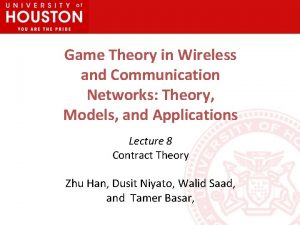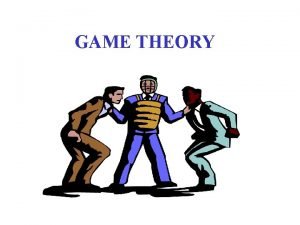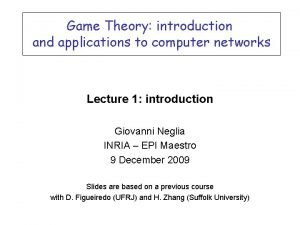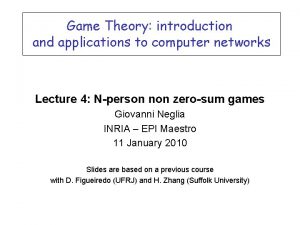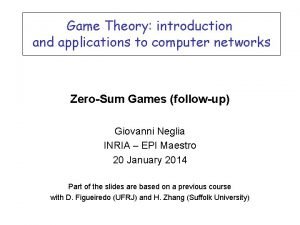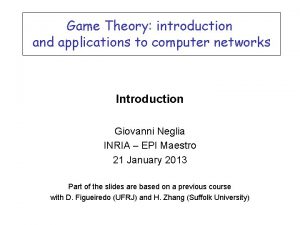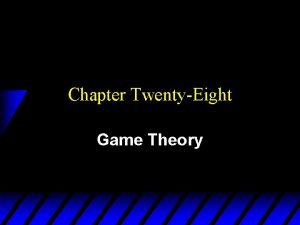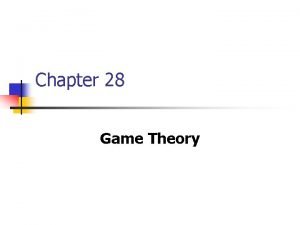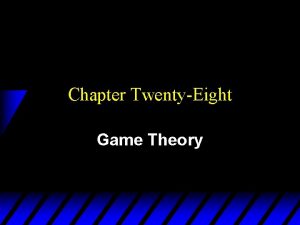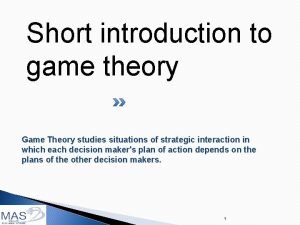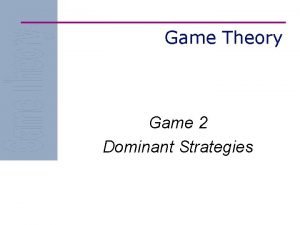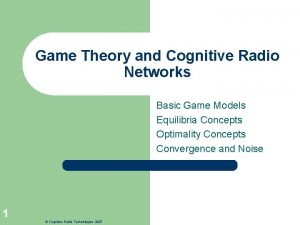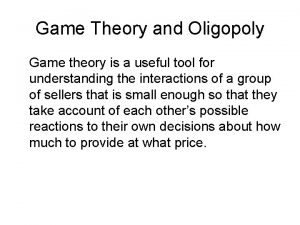Game Theory introduction and applications to computer networks










![Good news: Nash’s theorem [1950] r Every two-person games has at least one equilibrium Good news: Nash’s theorem [1950] r Every two-person games has at least one equilibrium](https://slidetodoc.com/presentation_image_h2/6d11a02d360de43a29827a6010e7a1bc/image-11.jpg)












- Slides: 23

Game Theory: introduction and applications to computer networks Lecture 2: two-person non zero-sum games (part A) Giovanni Neglia INRIA – EPI Maestro 14 December 2009 Slides are based on a previous course with D. Figueiredo (UFRJ) and H. Zhang (Suffolk University)

Outline r Two-person zero-sum games m Matrix games • Pure strategy equilibria (dominance and saddle points), ch 2 • Mixed strategy equilibria, ch 3 m m Game trees, ch 7 About utility, ch 9 r Two-person non-zero-sum games m Nash equilibria… • …And its limits (equivalence, interchangeability, Prisoner’s dilemma), ch. 11 and 12 m m Strategic games, ch. 14 Subgame Perfect Nash Equilibria (not in the book) Repeated Games, partially in ch. 12 Evolutionary games, ch. 15 r N-persons games

References r Main one: m Straffin, Game Theory and Strategy, The mathematical association of America r Subjects not covered by Straffin: m Osborne and Rubinstein, A course in game theory, MIT Press

Two-person Non-zero Sum Games r Players are not strictly opposed m payoff sum is non-zero Player 2 Player 1 A B A 3, 4 2, 0 B 5, 1 -1, 2 r Situations where interest is not directly opposed m players could cooperate m communication may play an important role • for the moment assume no communication is possible

What do we keep from zero-sum games? r Dominance r Movement diagram m pay attention to which payoffs have to be considered to decide movements Player 2 A B Player 1 A 5, 4 2, 0 B 3, 1 -1, 2 r Enough to determine pure strategies equilibria m but still there are some differences (see after)

What can we keep from zero-sum games? r As in zero-sum games, pure strategies equilibria do not always exist… Player 2 A B Player 1 A 5, 0 -1, 4 B 3, 2 2, 1 r …but we can find mixed strategies equilibria

Mixed strategies equilibria r Same idea of equilibrium m each player plays a mixed strategy (equalizing strategy), that equalizes the opponent payoffs m how to calculate it? Colin A Rose B A 5, 0 -1, 4 B 3, 2 2, 1

Mixed strategies equilibria r Same idea of equilibrium m each player plays a mixed strategy, that equalizes the opponent payoffs m how to calculate it? Rose considers Colin’s game Colin A B A -0 -4 4 1/5 B -2 -1 1 4/5

Mixed strategies equilibria r Same idea of equilibrium m each player plays a mixed strategy, that equalizes the opponent payoffs m how to calculate it? Rose Colin A B A 5 -1 B 3 2 3/5 2/5 Colin considers Rose’s game

Mixed strategies equilibria r Same idea of equilibrium m each player plays a mixed strategy, that equalizes the opponent payoffs m how to calculate it? Colin A Rose B A 5, 0 -1, 4 B 3, 2 2, 1 Rose playing (1/5, 4/5) Colin playing (3/5, 2/5) is an equilibrium Rose gains 13/5 Colin gains 8/5
![Good news Nashs theorem 1950 r Every twoperson games has at least one equilibrium Good news: Nash’s theorem [1950] r Every two-person games has at least one equilibrium](https://slidetodoc.com/presentation_image_h2/6d11a02d360de43a29827a6010e7a1bc/image-11.jpg)
Good news: Nash’s theorem [1950] r Every two-person games has at least one equilibrium either in pure strategies or in mixed strategies m Proved using fixed point theorem m generalized to N person game r This equilibrium concept called Nash equilibrium in his honor m. A vector of strategies (a profile) is a Nash Equilibrium (NE) if no player can unilaterally change its strategy and increase its payoff

An useful property r Given a finite game, a profile is a mixed NE of the game if and only if for every player i, every pure strategy used by i with nonnull probability is a best response to other players mixed strategies in the profile m see Osborne and Rubinstein, A course in game theory, Lemma 33. 2

Bad news: what do we lose? r equivalence r interchangeability r identity of equalizing strategies with prudential strategies r main cause m at equilibrium every player is considering the opponent’s payoffs ignoring its payoffs. r New problematic aspect m group rationality versus individual rationality (cooperation versus competition) m absent in zero-sum games Ø we lose the idea of the solution

Game of Chicken 2 2 Driver 1 r Game of Chicken (aka. Hawk-Dove Game) m driver who swerves looses Drivers want to do Driver 2 opposite of one another swerve stay Two equilibria: swerve 0, 0 -1, 5 not equivalent stay 5, -1 -10, -10 not interchangeable! • playing an equilibrium strategy does not lead to equilibrium

Prudential strategies r Each player tries to minimize its maximum loss (then it plays in its own game) Colin A Rose B A 5, 0 -1, 4 B 3, 2 2, 1

Prudential strategies r Rose assumes that Colin would like to minimize her gain r Rose plays in Rose’s game r Saddle point in BB r B is Rose’s prudential strategy and guarantees to Rose at least 2 (Rose’s security level) Rose Colin A B A 5 -1 B 3 2

Prudential strategies r Colin assumes that Rose would like to minimize his gain (maximize his loss) r Colin plays in Colin’s game r mixed strategy equilibrium, r (3/5, 2/5) is Colin’s prudential strategy and guarantees Colin a gain not smaller than 8/5 Rose Colin A B A 0 -4 B -2 -1

Prudential strategies r Prudential strategies m Rose plays B, Colin plays A w. prob. 3/5, B w. 2/5 m Rose gains 13/5 (>2), Colin gains 8/5 r Is it stable? m No, if Colin thinks that Rose plays B, he would be better off by playing A (Colin’s counter-prudential strategy) Colin A Rose B A 5, 0 -1, 4 B 3, 2 2, 1

Prudential strategies r are not the solution neither: m do not lead to equilibria m do not solve the group rationality versus individual rationality conflict r dual basic problem: m look at your payoff, ignoring the payoffs of the opponents

The Prisoner’s Dilemma r One of the most studied and used games m proposed in 1950 r Two suspects arrested for joint crime m each suspect when interrogated separately, has option to confess Suspect 2 NC C Suspect 1 NC C better outcome 2, 2 10, 1 1, 10 5, 5 payoff is years in jail (smaller is better) single NE

Pareto Optimal Suspect 2 NC C NC 2, 2 10, 1 Suspect 1 C 1, 10 5, 5 Pareto Optimal r Def: outcome o* is Pareto Optimal if no other outcome would give to all the players a payoff not smaller and a payoff higher to at least one of them r Pareto Principle: to be acceptable as a solution of a game, an outcome should be Pareto Optimal o the NE of the Prisoner’s dilemma is not! r Conflict between group rationality (Pareto principle) and individual rationality (dominance principle)

Payoff polygon Rose Colin A B A 5, 0 -1, 4 B 3, 2 2, 1 Colin’s payoff NE A, B B, A B, B A, A Rose’s payoff r All the points in the convex hull of the pure strategy payoffs correspond to payoffs obtainable by mixed strategies r The north-east boundary contains the Pareto optimal points

Exercises r Find NE and Pareto optimal outcomes: NC C NC 2, 2 10, 1 C 1, 10 5, 5 swerve stay swerve 0, 0 -1, 5 stay 5, -1 -10, -10 A B A 2, 3 3, 2 B 1, 0 0, 1 A B A 2, 4 1, 0 B 3, 1 0, 4
 Virtual circuit approach
Virtual circuit approach Computer networks and internets with internet applications
Computer networks and internets with internet applications Backbone networks in computer networks
Backbone networks in computer networks Business applications of computer networks
Business applications of computer networks Principles of network applications
Principles of network applications Business application in computer network
Business application in computer network Business application in computer network
Business application in computer network Game theory in wireless and communication networks
Game theory in wireless and communication networks Clemson canvs
Clemson canvs The pirate game
The pirate game Game lab game theory
Game lab game theory Liar game game theory
Liar game game theory Liar game game theory
Liar game game theory Game theory and graph theory
Game theory and graph theory Fuzzy sets and fuzzy logic theory and applications
Fuzzy sets and fuzzy logic theory and applications Intserv vs diffserv
Intserv vs diffserv Error detection and correction in computer networks
Error detection and correction in computer networks Character stuffing example
Character stuffing example Byte stuffing in networking
Byte stuffing in networking Arp and rarp in computer networks
Arp and rarp in computer networks Analog and digital signals in computer networking
Analog and digital signals in computer networking Web and http in computer networks
Web and http in computer networks Hamming distance in computer network
Hamming distance in computer network Protocols and standards in computer networks
Protocols and standards in computer networks







